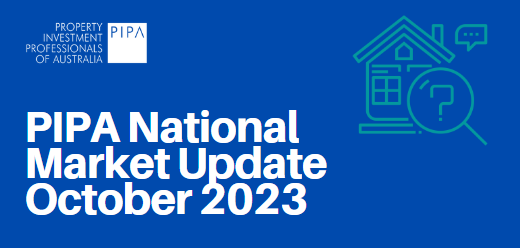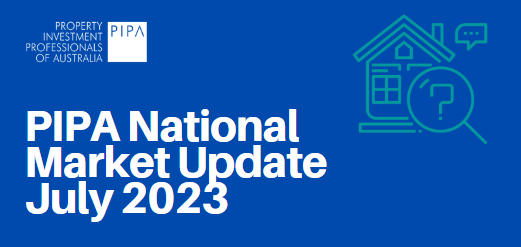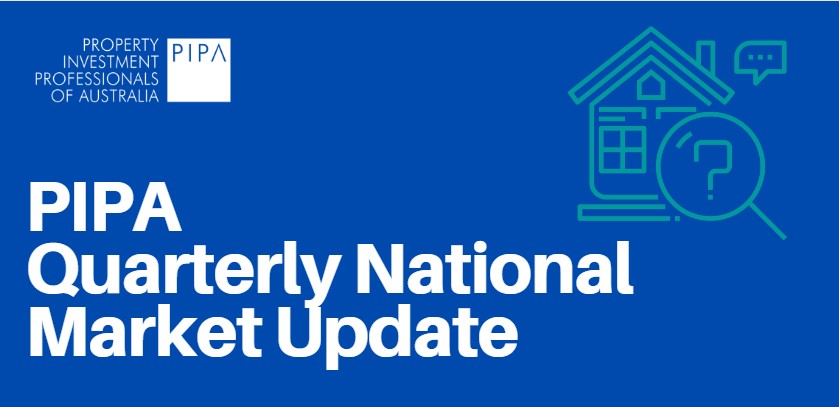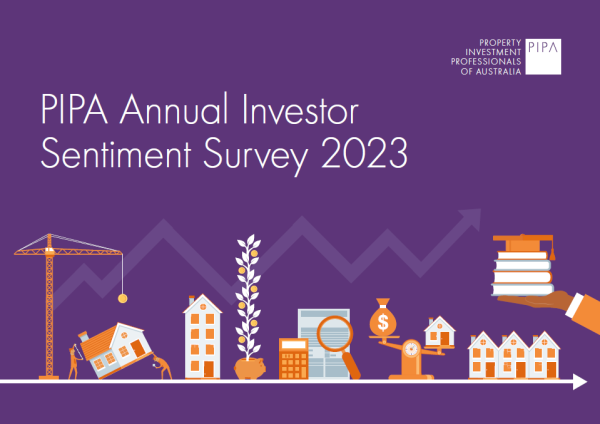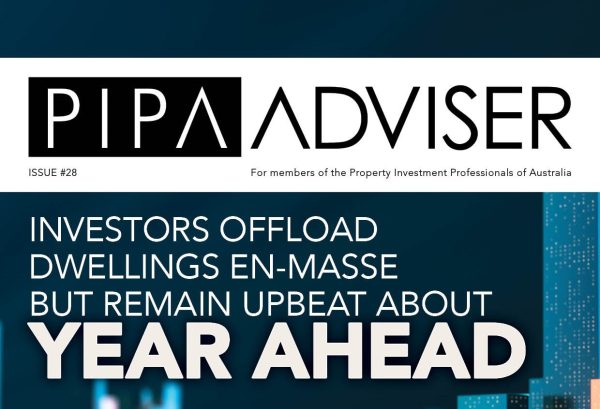PIPA National Market Update – April 2024
Apr 2024Karen Millers
Categories
Location ReportsMedia releasesNational market updatesPersonal advisersPIPA AdviserPIPA Annual Investor Sentiment SurveysPIPA Member ProfilesPIPA video updatesPIPA webinarsPodcastsProperty advisersProperty newsLatest Articles
Rent rises ease but crisis’ link to population density found to be tenuous
Jordan van den Berg: The ‘Robin Hood’ TikToker taking on Australian landlords
Victorian property investors face yet another new property tax as council tests levy
Rentvesting in Australia: A deep dive
‘More chance of winning lotto’ than housing targets being met
The first quarter of this year has continued to produce strong results with constrained listings underpinning Adelaide, Brisbane, and Perth in particular, according to the latest PIPA National Market Update.
This report pulls together insights and analysis from seven market experts and PIPA members from the latest edition of the PIPA Adviser e-magazine’s national market update.
PIPA Chair Nicola McDougall said some commentators have called time on the peak of buyer interest and sales activity in Perth, with median prices yet to reflect this potential state of play.
Market conditions in Brisbane and Adelaide remain robust, with Sydney resilient and Melbourne mostly stable – albeit with the significant exodus of investors from Victoria set to continue to negatively impact its rental crisis, she said.
“There is no question that we are in the middle of a housing crisis, with not enough dwellings available for rent or purchase in many areas of the country,” Ms McDougall said.
“Of course, we have heard the repeated assertions by the Federal Government of its plan to support the construction of 1.2 million new dwellings over the next five years, but everyone knows that figure has no basis in reality.
“I have a better chance of winning Lotto next week – and I don’t even have a ticket.”
According to the Australian Bureau of Statistics, net overseas migration was a staggering 550,000 in the year ending 30 September 2023 – a mind-boggling figure when we consider the lack of housing supply currently available for renters.
“Not only does that tap need to be turned off dramatically, but more needs to be done at a policy level to encourage investors back into the market to help remedy the rental catastrophe,” Ms McDougall said.
“An immediate reduction in the three percentage point borrowing serviceability buffer would be a good place to start.”
NEW SOUTH WALES
Veronica Morgan, Principal, Good Deeds Property Advisors
“Generally speaking, the NSW property market remains resilient, although there are some signs that 2024 might deliver more subdued sales and rental activity.
“Sydney house and unit prices each rose by 1% over the 3 months to March, according to Corelogic’s Hedonic Home Value Index. In regional NSW, units fared the best over the same period, recording a 1.2% increase, whereas house prices rose by 0.9%.
“Sydney dwelling values remain on an upward trajectory, albeit at a reduced growth rate than for much of 2023.
“In March, CoreLogic reported that upper quartile home values in Sydney exhibited a slower quarterly rate of appreciation compared to the broader middle and lower quartiles. Traditionally, the upper quartile of the housing market tends to spearhead cycles, both during upswings and downturns.
“Clearance rates are a particularly important metric in the inner Sydney market. They demonstrate not only buyer confidence, but also vendor willingness to meet the market.
“Auction listings volumes rose steadily through February and for the first three weeks, Domain recorded clearance rates between 72% and 75%, indicating a seller’s market. On the fourth weekend, listings reached 1004, which was the highest number of auctions held on any single weekend over the preceding 12 months and the clearance rate dipped to 68.2%.
“Over March, listings returned to more normal levels and the clearance rate hovered just above 70%, before dipping again on the third weekend to 65%, indicating a balanced market.
“Inventory levels are a valuable indicator of market conditions as they incorporate both supply and demand in a single metric. Markets with three months or fewer of inventory are more likely to experience sustained price growth.
“Analysis by Kent Lardner at Suburb Trends shows that inventory levels in regional NSW are higher than in Sydney, suggesting a reduction of sea- and tree-change migration, particularly outside the two-hour commute.
“Domain reported in February 2024 that Sydney’s vacancy rate reached an unprecedented low of 0.8% as a result of historically low supply levels. Nevertheless, both monthly and yearly averages for views per rental listing decreased, indicating a deceleration in demand.
“Suburb Trends reports that in much of NSW, rental expenses approach or surpass 40% of household income. On a global scale, allocating more than 30% of household income to rent is considered unaffordable.
“It reveals a significant trend: areas where rental costs exceed the 40% threshold are witnessing rises in vacancy rates, indicating a potential tipping point for many markets.”
VICTORIA
Matt Skehan, Azure Buyers Agents
“In February, Melbourne property values rose by 0.1%. This stopped the decline of growth that occurred from the back end of 2023. Melbourne’s property values now sit 4.1% below their peak achieved in March 2022. A median priced house in Melbourne now costs $942,779 (CoreLogic).
“The Victorian market has navigated numerous headwinds over the past few years from the onset of COVID-19, hard lockdowns, interest rates rises and the cost-of-living crisis to name a few.
“However, it has remained remarkably resilient and despite not having the heady growth of some other cities these past 12 months, it has stabilised and appears ready to rebound as consumer confidence improves and interest rates decline.
“The Melbourne auction market has started the year strongly showing a significant depth of buyers in the marketplace. The auction clearance rates have consistently been above the 60% level each week (Domain).
“Despite a lot of negative press, in particular surrounding the increased taxes associated with owning a property in Victoria, it is hard not to like the fundamentals of the market from a demand and supply perspective and the fact it is one of our largest population and economic centres.
“The rental market is extremely tight with a current vacancy rate of 1% (SQM) and rental rates have increased 10.8% over the past 12 months, the second highest gain in the country over this period (CoreLogic).
“Population growth has been strong into Victoria with high levels of net overseas migration putting further pressure on our already stretched rental market. This is due to a combination of our desirable liveability, good schools, and relatively affordable housing options.
“There is significant infrastructure spending happening within the State with the Metro Tunnel project, West Gate tunnel project and the Suburban rail loop project to name a few.
“I anticipate that the data over the coming months will show a turning market in Melbourne this year. Melbourne offers plenty of upside with its recent underperformance from a growth perspective providing an opportunity for the savvy buyer.
“For those playing the long game and looking to park their capital in a large and growing city, Melbourne offers up some strong and exciting prospects.”
QUEENSLAND
Melinda Jennison, Managing Director, Streamline Property Buyers
“The Queensland Property Market has been a top performer since the onset of COVID19, with property values across the State reaching a new peak at the end of February 2024 according to CoreLogic data.
“In Brisbane, values have increased 53.5% since March 2020 up to the end of February 2024, and regional markets across the State have increased 54.4% throughout the same period.
“This growth puts Queensland as the second-fastest growing property market over this timeframe, only slightly behind South Australia in terms of total growth and well above the growth for the combined capitals and combined regional markets nationally.
“Brisbane’s market growth has been strong over the last 12 months, after price falls throughout 2022. Over the past 12 months, property values increased 15.6% based on CoreLogic indicators, compared to the growth in regional Queensland which was 10%.
“The rate of growth in Brisbane and Queensland’s regional markets continues to outperform the national average on both a monthly, quarterly, and annual basis, thus confirming the ongoing strength across the Queensland market.
“CoreLogic has reported that since the commencement of the upswing, across all of Australia, capital city house values have surged 11.6% higher, while unit values are up 7.6%. In Brisbane, house values have increased 15.9% and unit values have grown 14.6%. The performance in both segments of the Brisbane market has been superior to the capital city growth at a national level, but the undeniable difference is the surge in unit values in Brisbane, relative to the national average.
“Part of the reason for the continued upward price pressure throughout Queensland is due to low listing volumes throughout most regions, relative to the long-term average. Additionally, in Brisbane, compared to 12 months ago, total listings throughout February were down 15.7%, according to SQM Research.
“The rental market is tight across most of Queensland with vacancy rates, according to SQM Research, at or near record lows. The regions within the State with the highest vacancy rates up to February 2024 included Brisbane CBD and North Queensland, both at 1.8%. All other regions across the state are less than 1.3%, with the tightest areas being Central Queensland at 0.5% and Queensland’s Far North Coast at 0.1%.
“This is obviously putting upward pressure on rents as Queensland’s population continues to surge. According to CoreLogic, in Brisbane house rents have increased 7.5% over the last 12 months and unit rents are up 12.3%.
“With recent inflationary falls, the outlook for interest rates is more optimistic which may lead to a boost in buyer confidence. Potential borrowing capacity improvement could further enhance confidence, increasing demand throughout the latter months of this year.
“Despite the uncertainties, Brisbane and Queensland show ongoing price growth pressure based on their underlying fundamentals, albeit the rate of growth is expected to be more moderate than 2023’s surge.”
SOUTH AUSTRALIA
Peter Koulizos, Lecturer, Master of Property, The University of Adelaide
“I wrote the South Australian commentary for the PIPA Adviser exactly one year ago. Not much has changed as the Adelaide property continues to go from strength to strength.
“Even though Adelaide’s increase in home values of 12.6% over the past 12 months was overshadowed by the increases of home values in the Brisbane and Perth property markets, Adelaide’s medium- to long-term performance has been stellar.
“Change in capital city dwellings values since the onset of COVID to February 2024 (CoreLogic).
Adelaide – 55.3%
Brisbane – 53.5%
Perth – 52.9 %
ACT – 31.0%
Hobart – 27.3%
Sydney – 24.8%
Darwin – 24.6%
Melbourne – 11.0%
“During this period of time, Adelaide was the best performing capital city in Australia.
Let’s go further back in time and have a look at the performance of house prices over the past 20 years, according to ABS established house median prices, from December 2003 to December 2023:
Hobart – 284.6%
Adelaide – 207.1%
Brisbane – 180.0%
Perth – 166.0%
Melbourne – 162.5%
Canberra – 161.3%
Sydney – 161.5%
Darwin – 158.8%
“Over the past 20 years, then, Adelaide is the second-best performing house market, where prices have more than tripled.
“The increase in rents has been almost as stellar as the increase in property prices, especially since the onset of COVID-19.
“Change is dwelling rents since onset of COVID to February 2024 (CoreLogic).
Perth – 53.8%
Adelaide – 38.5%
Brisbane – 37.0%
Darwin – 34.2%
Sydney – 28.6%
Melbourne – 23.0%
ACT – 14.2%
Hobart – 14.0%
“Enough about the past, what about the future? I’m glad you asked!
“Many financial advisors will state that past performance is no guarantee of future performance, but I think it can give us a guide to future performance, especially if the factors that have influenced the market in the past will continue to do so into the future.
“I can’t give detailed reasons as to how I think the Adelaide residential property prices will perform as I’m supposed to write about 400 words for this article but let me make a bold prediction.
“I feel that I am in a reasonable position to make this prediction as I have been teaching in property for almost 30 years. I could be horribly wrong but here goes:
Adelaide’s property market will continue to grow from strength to strength, so much so that within two years, Adelaide’s median dwelling values will be higher than Melbourne’s median dwelling values.
“I am not trying to put down the Melbourne property market but as many of my property colleagues are based in Melbourne and two of the PIPA board members are based in Melbourne, it will certainly provide for some very interesting discussions. Only time will tell if I am correct!”
TASMANIA
Dr Kevin Hoang, Economist and Head of Research, inSynergy Advisory
“Tasmania is the sixth largest state in Australia in terms of population, with 572,000 people, and the seven largest economy with a Gross State Product (GSP) of $38.5 billion in 2022-2023. The state is well-known in both the Australian and international markets for high-quality food and agricultural products, such as salmon, cherries, and dairy products.
“Currently, with a median house price of $750,000, which is 110% lower than Sydney’s median price, housing prices in Hobart are among the most affordable in the country. Coupled with a low vacancy rate of 1.2% and good yields of 4.7% for units and townhouses, there is considerable appetite from interstate investors who are seeking affordable properties in capital cities.
“From a historical perspective over the past 34 years, from 1980 to 2024, house values in Hobart have increased by nine times, demonstrating its resilience over a long timeframe and being relatively comparable to accumulated growth in other capital cities such as Sydney (9.5 times), Canberra (9 times), and Brisbane (8.7 times).
“The Tasmanian government has put forward a bold plan to accelerate infrastructure investment worth over $27 billion over the next 10 years. This includes major projects such as the Marinus Link – connecting electricity and telecommunications between Tasmania and Victoria ($3.3 billion), the Robbins Island Wind Farm ($1.6 billion), the ABEL Energy Bell Bay PowerFuels Project – with the aim of producing 300,000 tonnes of renewable methanol per year ($1 billion), and the Hobart’s New Arts, Entertainment, and Sport Precinct – estimated to generate billions in economic activities and thousands of jobs during and post-construction ($750 million), among other projects.
“However, the city is also facing challenges as observed in other similar small cities, such as (1) an ageing population, (2) a small and less diversified economy that may not provide diverse types of jobs as in larger states, and (3) the lowest population growth rate in the country, at 0.3% in the 2022-23 financial year (against 3.1% in Western Australia, 2.7% in Victoria and 2.6% in Queensland), mainly due to a low birth rate and the out-migration of its young people to the mainland states for jobs.
“A low population growth rate means less demand for housing, goods, and services, eventually posing challenges for the state’s sustainable economic growth in the years to come. Therefore, the prospect for housing values in Tasmania to significantly take off in the coming years is somewhat limited.
“Against the backdrop of the state’s economic and demographic landscape, most investment-grade locations are likely located in Hobart and Launceston’s inner and city fringe suburbs, where housing demand and values tend to trend up consistently over time and are less volatile due to external economic factors.”
ACT
Claire Corby, Buyers’ Agent, Capital Buyers Agency
“In the ACT, it’s a mixed bag for 2024 and only when diving below the headlines can we see what’s transpiring in the Canberra market of late.
On the supply side of the real estate equation listings have notably picked up in the early months of this year. The catch-cry of 2023 was of no stock on the market and rarer still, perennially popular A-grade family homes.
“Vendors have now brought homes to market which has spiked supply in this first quarter, alongside investors selling up. Many investors are selling in response to increased Government compliance, rising holding costs, stagnant rental prices, and our lack of a land tax threshold.
“In short, investors sensitive to yield are leaving in search of greener pastures with better cash flow. This increase is supply has brought many options to a starved buyer cohort who, until recently, were a flock of seagulls on a lone hot chip at the beach.
“Lacking a beach here, perhaps the lawns of Parliament House is a more apt setting.
Auction clearance rates in the ACT have been hovering around the 50% mark throughout the first quarter of 2024 reflective of increased supply – but what of those hungry buyers?
“With interest rates seemingly levelled, Canberrans are feeling confident in their repayment calculators and are bidding up a storm. Only select homes are in strong demand though; the winning combination of renovated interiors, sought-after school catchment areas and inner-city addresses have drawn bidders to pay above reserve while many other homes are overlooked and sit on the market to ponder their shortcomings.
“Two particular buyer pools have been especially active – downsizers and first home buyers. The sale of the family home in the inner ‘burbs has provided downsizers with deep pockets, short timeframes, and a desire to stay centrally located. First home buyers are more susceptible to interest rates but are increasingly helped along by the BoMD (Bank of Mum and Dad), with the tell-tale lean across on auction day for the kids to continue bidding.
“With more builders going into liquidation and rising costs of materials, the appetite for renovation is plummeting and properties in need of work are passed over for their prettier counterparts.
“The low auction clearance rate masks the two-speed market currently in play. As the market heads into some of the busiest auction weekends dodging holiday periods this autumn, it’s likely that the statistics for the ACT will continue to report a flatline for the quarter but the story behind the data tells a different tale.
WESTERN AUSTRALIA
Terry Ryder, Director, Hotspotting
“We see the Perth market as having passed its peak in terms of market activity, although the price data remains strong.
“It’s a classic scenario when a market reaches its peak, but it takes time before it’s reflected in the price statistics, which always lag.
“It’s a major trap for investors who are still piling into that market and buying recklessly.
“Other parts of WA have better prospects, including regional centres like Bunbury, Mandurah, and Geraldton.
“However, there are three locations that recently featured in our National Top 10 Positive Cash Flow Hotspots research that are worthy of investigation by investors.
There has already been much written about Perth’s price growth, but it’s important to understand the city – like other cities – has areas that are performing better than others.
“A case in point is Orelia in Kwinana, where not only has it produced 20% annual growth but it also the second fastest growing LGA in Western Australia.
“Investors are increasingly being attracted to the region – about 40 kilometres south of the central city – by its affordable property prices with it being the most affordable precinct in the metro area.
“But don’t let its cheap property price tags put you off, because the region is also home to billions of dollars of new infrastructure and is forecast to create some 10,000 jobs over the next three decades.
“With a vacancy rate of just 0.4%, it is also little wonder that Geraldton – about four hours’ north of Perth – is increasingly attractive to investors.
“Geraldton is the largest city north of Perth and has experienced stellar economic growth over recent years – partly due to its affordable property prices.
“It is also the commercial hub for the region and is home to WA’s second largest port, which are both factors that continue to underpin its local economy.
“While its annual growth had been benign over the past year, the future prospects for Geraldton remain strong.
“Home of one of Australia’s biggest regional ports, Bunbury also boasts an increasingly desirable seaside lifestyle.
“Its position in Western Australia’s beautiful south-west region has long attracted a steady stream of new migrants – a fact that has resulted in its population growing much faster than the national average.
“It also has a number of major infrastructure projects under way, including the $278 billion Bunbury Hospital and the $800 million Greenbushes lithium mine expansion.
“First homebuyers had been targeting Withers in particular due to its affordable property prices, but investors are showing a keen interest as well.
“There are very few major regions left where you can purchase a house in the $300,000 to $400,000 price bracket that also offer strong rental yields and the prospect for future capital growth.”
ENDS
Bricks & Mortar Media | media@bricksandmortarmedia.com.au
